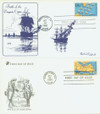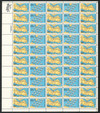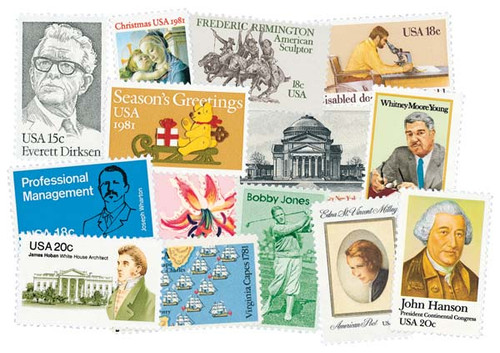
# 1937-38 - 1981 18c Battles of Yorktown and Virginia
This pair of stamps recalls the final battle of the American Revolution. After the British moved into Virginia, George Washington and the Comte de Rochambeau combined their French and American armies. With the help of the French fleet, they joined Lafayette and attacked Yorktown. The British commander, Cornwallis, was forced to surrender, bringing to an end the war in America.
Battle Of The Virginia Capes
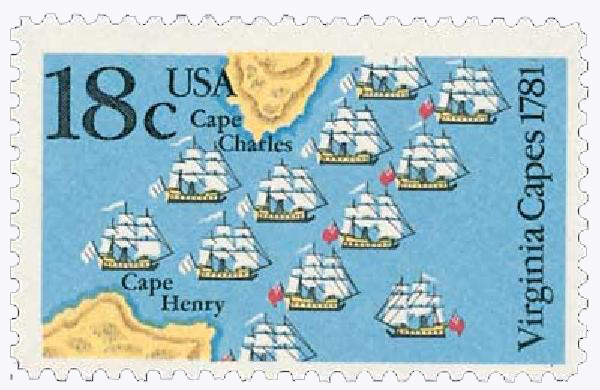
On September 5, 1781, French forces won a decisive victory at the Battle of the Virginia Capes. The eventual siege of Yorktown was a success due to the joint efforts of the French fleet and the French and American troops on land.
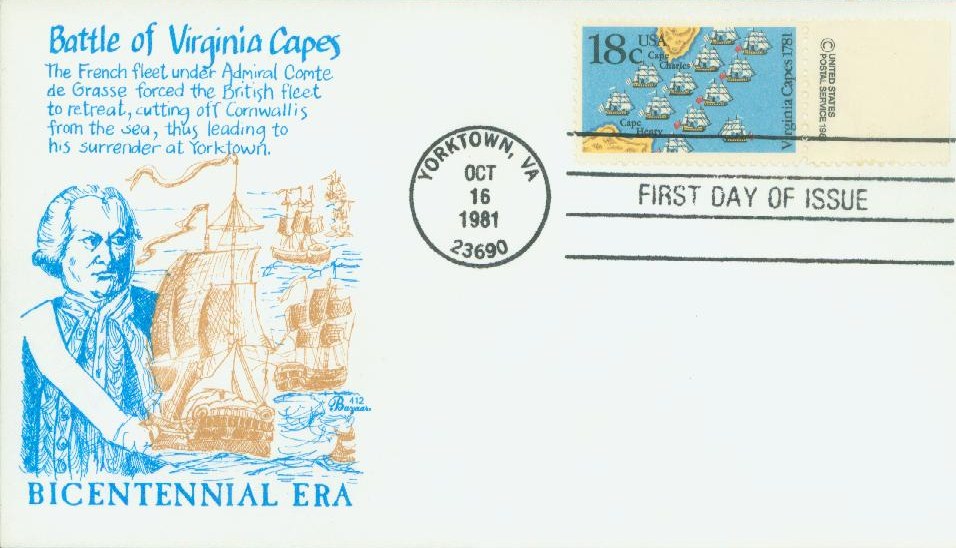
During the American Revolution, the ability to resupply armies, deploy troops, and transport munitions stored in towns along Virginia’s inland water routes was dependent on control of the Chesapeake Bay. Virginia’s Chesapeake Bay is strategically located at the mouth of the James and York Rivers.
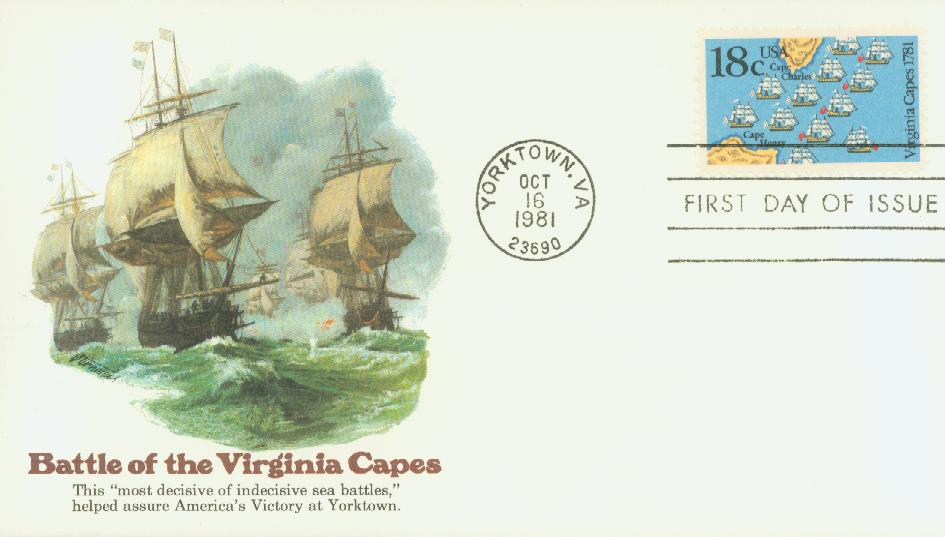
In 1779, a British fleet seized control of the Chesapeake Bay, dropped additional forces, and destroyed forts and military warehouses along the inland rivers. The raids gave the British necessary supplies at the same time they depleted the Continental Army’s stockpiles. British expeditionary forces continued the raids throughout 1780 and highlighted Virginia’s military weakness. In the spring of 1781, Major General Marquis de Lafayette entered Virginia and combined his forces with those of General Anthony Wayne. They reached Richmond just in time to prevent the British from burning the capital.
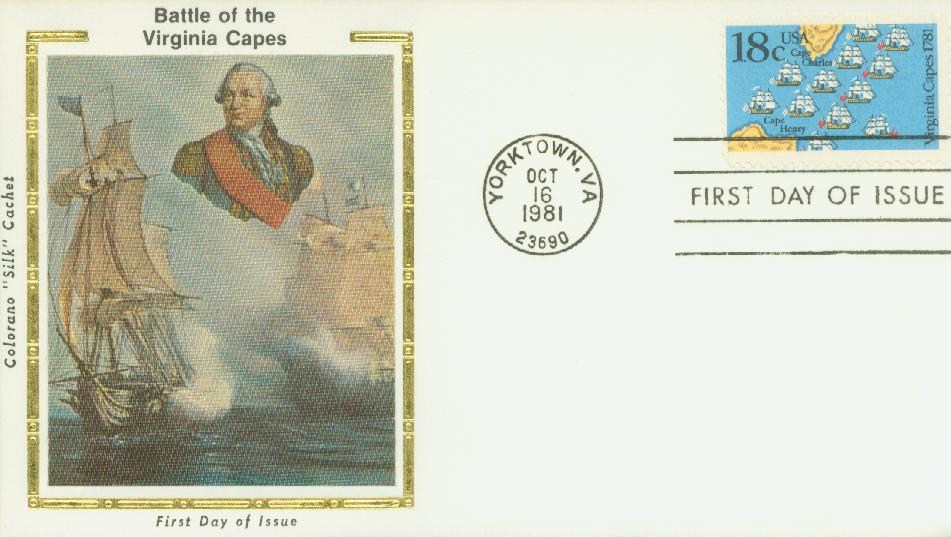
As Lafayette’s forces defended Richmond, British General Lord Charles Cornwallis traveled southward along the James River. Joined by other British forces, Cornwallis managed to maneuver around Lafayette’s Continental Army and reach Yorktown on the York River. British naval ships delivered additional troops. On August 2, 1781, Cornwallis began construction of two rights of defensive lines around Yorktown.

Word of Cornwallis’ movements reached General George Washington, who met with French General Rochambeau to determine their next move. Rochambeau convinced Washington to move south and surround the city by land. A fleet under the command of French Admiral de Grasse would secure the Chesapeake Bay and cut off Cornwallis’ escape route on the river.
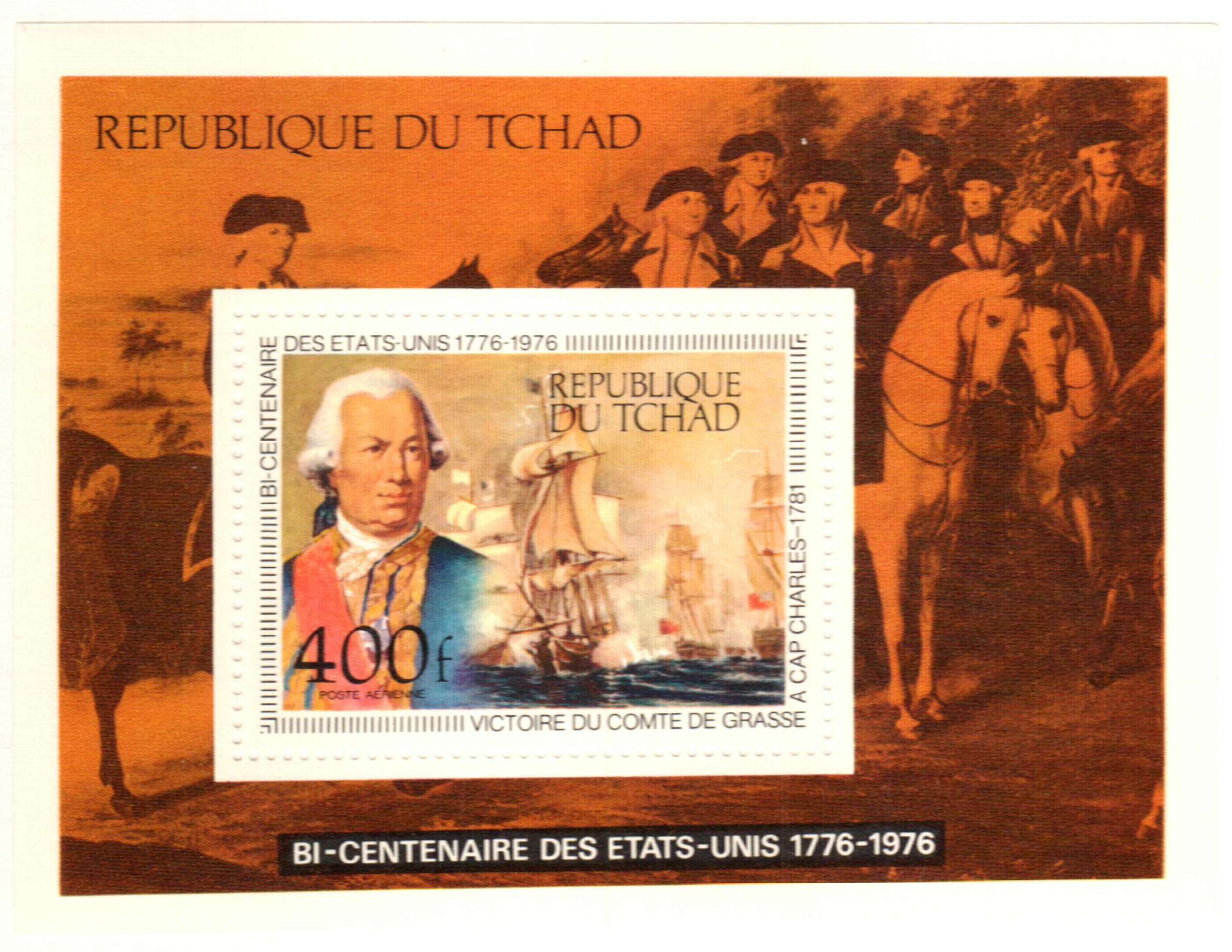
The French fleet of 27 ships reached Virginia on August 28, 1781, and immediately started a blockade of the York and James Rivers. Additional French troops were delivered to strengthen Lafayette’s forces on land.

At about 9:30 am on September 5, patrol ships from the British and French navies spotted each other’s fleets. Both underestimated the size of their opposition, believing it to be the smaller fleet of Admiral de Barras. Two hours later, the French fleet left the bay and sailed out to meet the British. The battle finally began about 4:00 pm, with the British firing the opening shot. The French used their customary tactic of firing on masts and rigging, to hinder the British mobility.
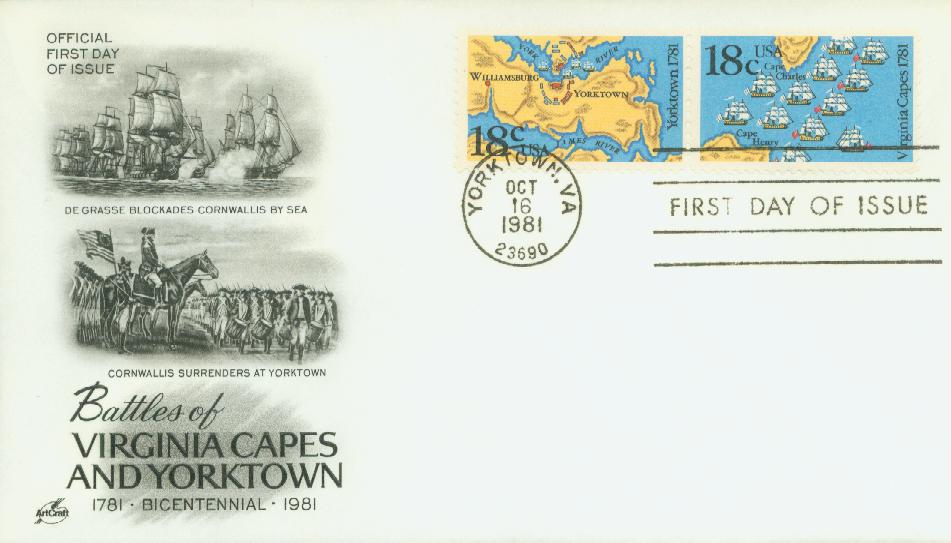
The fighting continued until sunset. After that, the British commander assessed the situation and concluded that the French hadn’t suffered nearly as much damage as his ships had. De Grasse reached the same conclusion. Originally, the British commander expected to be able to repair his ships and resume the fighting, but the repairs were too significant. As the British fleet drifted eastward, the French turned back to the Chesapeake Bay on September 9. The British fleet then turned north and sailed toward New York.

The Battle of the Virginia Capes left the French Army firmly in control of the Chesapeake Bay and the entrances to the James and York Rivers. As a result, the British garrisons at Yorktown and Gloucester Point were completely isolated from resupplies or reinforcement.
In mid-September, Washington’s troops combined with Lafayette’s for a total of 17,600 soldiers opposite the 8,300 entrenched with General Cornwallis. The siege of Yorktown began on October 9, 1781, with heavy artillery fire on the British defensive line. After a week of heavy battle, the British attempted to evacuate across the York River. However, the British ships that were to transport them had scattered or sunk in a violent storm. With their escape route cut off and the entrances to the York River and the Chesapeake Bay blocked, Cornwallis surrendered at Yorktown, the last major land battle of the war.
This pair of stamps recalls the final battle of the American Revolution. After the British moved into Virginia, George Washington and the Comte de Rochambeau combined their French and American armies. With the help of the French fleet, they joined Lafayette and attacked Yorktown. The British commander, Cornwallis, was forced to surrender, bringing to an end the war in America.
Battle Of The Virginia Capes

On September 5, 1781, French forces won a decisive victory at the Battle of the Virginia Capes. The eventual siege of Yorktown was a success due to the joint efforts of the French fleet and the French and American troops on land.

During the American Revolution, the ability to resupply armies, deploy troops, and transport munitions stored in towns along Virginia’s inland water routes was dependent on control of the Chesapeake Bay. Virginia’s Chesapeake Bay is strategically located at the mouth of the James and York Rivers.

In 1779, a British fleet seized control of the Chesapeake Bay, dropped additional forces, and destroyed forts and military warehouses along the inland rivers. The raids gave the British necessary supplies at the same time they depleted the Continental Army’s stockpiles. British expeditionary forces continued the raids throughout 1780 and highlighted Virginia’s military weakness. In the spring of 1781, Major General Marquis de Lafayette entered Virginia and combined his forces with those of General Anthony Wayne. They reached Richmond just in time to prevent the British from burning the capital.

As Lafayette’s forces defended Richmond, British General Lord Charles Cornwallis traveled southward along the James River. Joined by other British forces, Cornwallis managed to maneuver around Lafayette’s Continental Army and reach Yorktown on the York River. British naval ships delivered additional troops. On August 2, 1781, Cornwallis began construction of two rights of defensive lines around Yorktown.

Word of Cornwallis’ movements reached General George Washington, who met with French General Rochambeau to determine their next move. Rochambeau convinced Washington to move south and surround the city by land. A fleet under the command of French Admiral de Grasse would secure the Chesapeake Bay and cut off Cornwallis’ escape route on the river.

The French fleet of 27 ships reached Virginia on August 28, 1781, and immediately started a blockade of the York and James Rivers. Additional French troops were delivered to strengthen Lafayette’s forces on land.

At about 9:30 am on September 5, patrol ships from the British and French navies spotted each other’s fleets. Both underestimated the size of their opposition, believing it to be the smaller fleet of Admiral de Barras. Two hours later, the French fleet left the bay and sailed out to meet the British. The battle finally began about 4:00 pm, with the British firing the opening shot. The French used their customary tactic of firing on masts and rigging, to hinder the British mobility.

The fighting continued until sunset. After that, the British commander assessed the situation and concluded that the French hadn’t suffered nearly as much damage as his ships had. De Grasse reached the same conclusion. Originally, the British commander expected to be able to repair his ships and resume the fighting, but the repairs were too significant. As the British fleet drifted eastward, the French turned back to the Chesapeake Bay on September 9. The British fleet then turned north and sailed toward New York.

The Battle of the Virginia Capes left the French Army firmly in control of the Chesapeake Bay and the entrances to the James and York Rivers. As a result, the British garrisons at Yorktown and Gloucester Point were completely isolated from resupplies or reinforcement.
In mid-September, Washington’s troops combined with Lafayette’s for a total of 17,600 soldiers opposite the 8,300 entrenched with General Cornwallis. The siege of Yorktown began on October 9, 1781, with heavy artillery fire on the British defensive line. After a week of heavy battle, the British attempted to evacuate across the York River. However, the British ships that were to transport them had scattered or sunk in a violent storm. With their escape route cut off and the entrances to the York River and the Chesapeake Bay blocked, Cornwallis surrendered at Yorktown, the last major land battle of the war.







